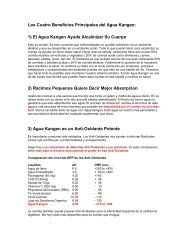ACID-ALKALINE BALANCE: ROLE IN CHRONIC ... - My Kangen Tools
ACID-ALKALINE BALANCE: ROLE IN CHRONIC ... - My Kangen Tools
ACID-ALKALINE BALANCE: ROLE IN CHRONIC ... - My Kangen Tools
You also want an ePaper? Increase the reach of your titles
YUMPU automatically turns print PDFs into web optimized ePapers that Google loves.
Acid-electrolyzed<br />
water for<br />
sterilization<br />
Alkalineelectrolyzed<br />
water<br />
Survival number (Log cfu g –1 )<br />
5<br />
HCl<br />
HClO<br />
NaOH<br />
+<br />
Cl 2<br />
H 2<br />
–<br />
H + OH –<br />
Cl – Na +<br />
~Chemical reaction~<br />
:<br />
2OH – ®H 2<br />
O+1/2O 2<br />
+<br />
2e –<br />
2Cl – ®Cl 2<br />
+2e –<br />
Cl 2<br />
+H 2<br />
®HClO+HCl<br />
(low pH condition)<br />
HClO®H + +ClO –<br />
(high pH condition)<br />
:<br />
2H + +2e – ®H 2<br />
4<br />
3<br />
2<br />
1<br />
NaCl<br />
Tap water<br />
with NaCl<br />
NaCl<br />
Separation<br />
membrane<br />
Fig. 1. Principle of acidic electrolyzed water. Left: process<br />
flow of apparatus, right: chemical reaction during electrolyzing<br />
process.<br />
0<br />
A B C D<br />
Fig. 2. Sterilization effects of combination of<br />
electrolyzed water on rice preparation. (A) Control<br />
rice, (B) washing with AlEW (5 min), (C)<br />
soaking with AcEW (30 min) after B treatment,<br />
(D) soaking with D/W (30 min) after C treatment.<br />
through the electrolysis apparatus and voltage between the electrodes<br />
were set at 14A and 18V, respectively. AcEW was prepared<br />
within the anode region of the electrolytic cell, and AlEW<br />
was prepared within the cathode region. The physicochemical<br />
properties of electrolyzed water are as follows:<br />
AcEW: pH 2.7, oxidation reduction potential (ORP)<br />
1,481 mV, available chlorine concentration 51.5 ppm.<br />
AlEW: pH 11.6, ORP –576 mV.<br />
We used distilled water as a control processing solution.<br />
Polished rice (Kinuhikari) was purchased and used as a<br />
sample. Prepared Bacillus subtillis PCI219 was used as a heatresistant<br />
spore sample.<br />
Some 1 mL of spore solution (10 9 cfu mL) was added to<br />
9 mL of AcEW and mixed. The sample was collected from the<br />
mixed solution every 1 min and the survival number counted<br />
in each sample after cultivation.<br />
Some 100 g of polished rice were prepared for each<br />
preparation test. We devised a preparation process with 3 stages<br />
(washing: 5 min, soaking 1 ½ min, soaking 2 ½ min). We used<br />
AcEW, AlEW, and distilled water, respectively, as each stage<br />
solution. pH and color of rice were measured by a conventional<br />
pH meter and color meter.<br />
To confirm the microorganism control effect, we added<br />
the B. subtillis spore into the rice and we counted the survival<br />
number in each sample of the preparation test.<br />
Results and discussion<br />
We examined several tests to prove the influence on the microorganism<br />
and the change in the raw rice.<br />
AcEW and AlEW changed the color and pH of rice rapidly.<br />
But, when the rice was treated with a combination of electrolyzed<br />
water (washing with AlEW, soaking with AcEW, and<br />
soaking with distilled water), pH and color of the treated rice<br />
were no different from conventional washing and soaking with<br />
distilled water.<br />
AcEW showed a strong effect on microorganism control,<br />
even on heat-resistant spores in vitro. However, in the<br />
rice preparation test, AcEW could not kill B. subtillis spores<br />
on the rice completely. But, after washing by AlEW, AcEW<br />
could kill completely. So, finally, we set the optimum method<br />
of combination of electrolyzed water as follows. To remove<br />
rice bran powder and other foreign materials that coat the surface<br />
of the raw rice, at first we washed the rice with AlEW for<br />
5 min and soaked it with AcEW to sterilize microorganisms<br />
for 30 min. Then, to remove the odor of chlorine and to revert<br />
the pH level, we resoaked the rice with distilled water for 30<br />
min. Figure 2 shows the effects against microorganisms using<br />
the combination process of each electrolyzed water.<br />
In this experiment, we could confirm the effect of the<br />
combination of electrolyzed water on microorganism control.<br />
This effect can be considered the result of available chlorine<br />
concentration and the rapid change in pH and it raises the sen-<br />
Session 9: Developing new uses of rice 271



